
|
||
|
Portland art blog + news + exhibition reviews + galleries + contemporary northwest art
|
||
Brenna Murphy at Upfor Pattern is information. Whether it be; lace, proteins, cities, ceremonies, binary code, languages or maps of the internet, all have a crystalline organized structure to them. Patterns are used extensively in places of worship, military maneuvers, theaters, sporting events, dance clubs and other large public gathering spaces, employing recurring visual motifs to emphasize collective attention.
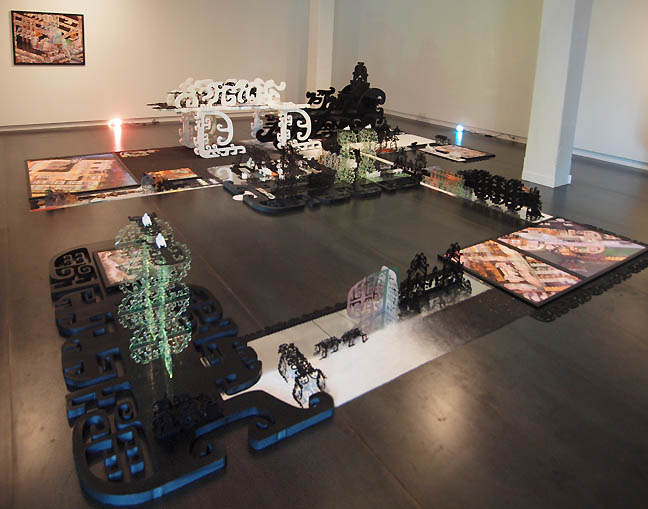
Brenna Murphy's Lattice~Face Parameter Chant (all show photos Jeff Jahn) Simply, our brains (and computers) are trained to recognize pattern and it is precisely why Brenna Murphy's Lattice~Face Parameter Chant at Upfor gallery is the most talked about show in town this month (beating out hefty competition from Chuck Close, The CNAA's, Dinh Q. Le and Josiah McElhney etc.). All of these are worthy shows but Murphy's is exquisite and a moment of revelation for the Portland art scene, which hasn't had a show like this in a commercial gallery since the much missed NAAU space shut its doors in 2012. 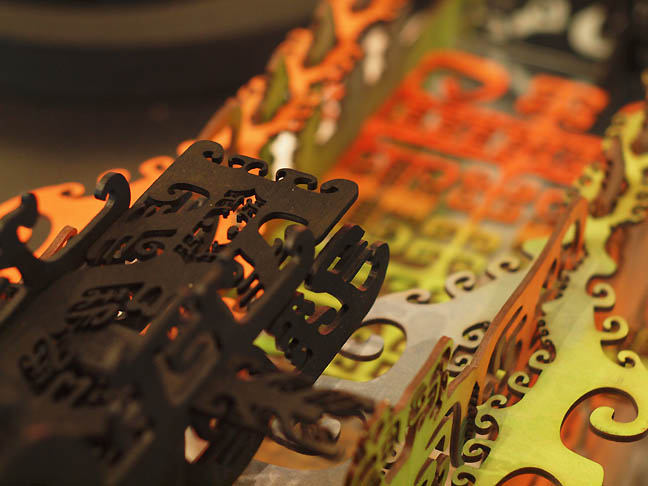
Why is it so interesting? Partly, it is because Murphy's anthropological gumbo of patterns gives nods to Mayan, Chinese and Navajo designs, mostly rendered by computers... simply resonates more with our times. We live in an age where everything has been reduced data and algorithms to process it with little input from those the data represents. Conversely, one can also think of Murphy's installation as a labyrinth of access or a type of encryption as personal expression. In that reading the artist then becomes tribal shaman of her own cult of information. This becomes all the more appealing when one considers how much information Google, Facebook and Microsoft etc. all collect and consider their property. 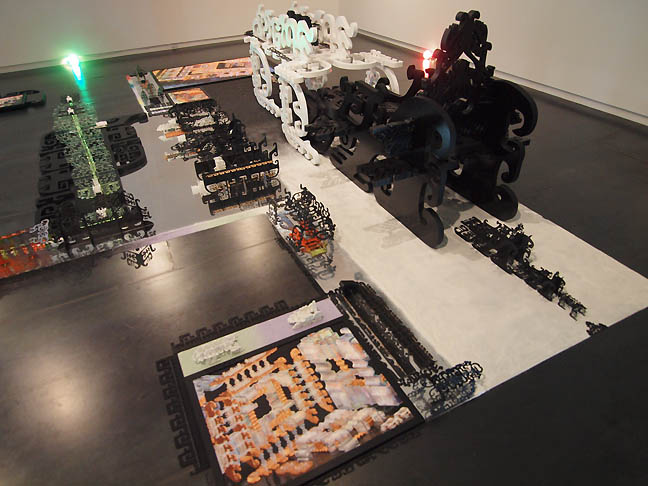 Insect (white), Vehicle (black), top right corner The show is inherently arcane but perhaps the two larger works on display titled Insect and Vehicle are the keys to the code here? They do have a nice Yin and Yang white and black polarity to them. Many civilizations express these counterparts so it makes sense an artist would create her own lexicon. 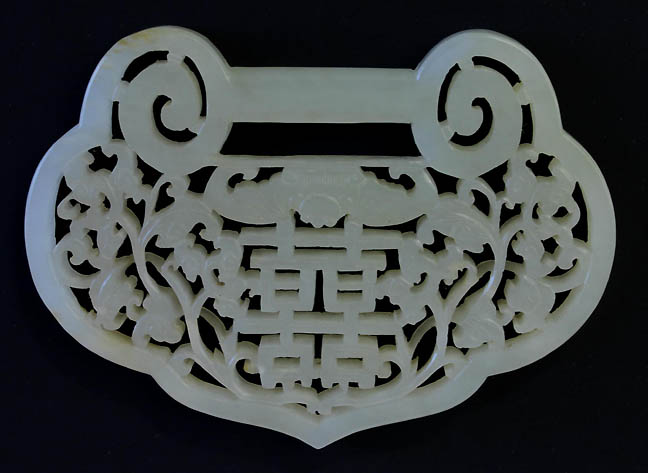 A Chinese Lingzhi shaped white jade pendant The large white piece does look like an insect from above but it also reminds me the bas-relief depiction of a Mayan king in his headdress. Its curved flourishes also resemble the Buddha's elongated earlobes and Chinese Lingzhi fungus (which denoted rank and immortality). The Vehicle resembles Mayan symbols as well and the pairing of the two seems to invite a pairing and mythos. Where is this insect about to go in this vehicle? 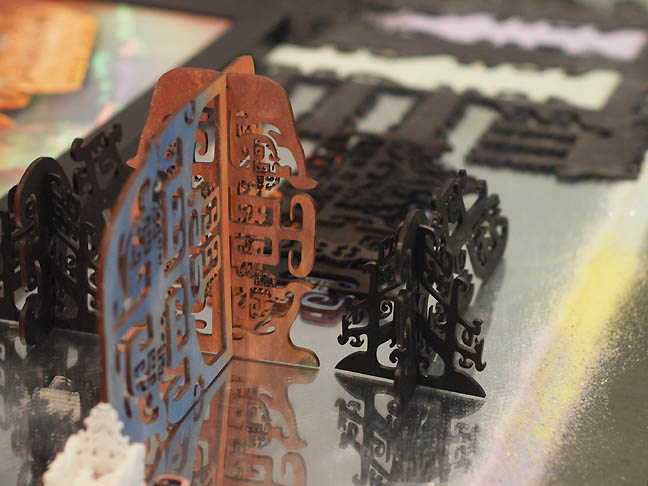
Like many intricate patterns there is a lot of bifurcation and recursion of line that can be combined. Like Maori face tattoos there is an otherness conveyed by these designs... making them mysterious and by trying to understand them the viewer may see faces in them. Thus, in some ways these could bee seen as existential tattoos manifest as sculpture. The forms of the Insect and Vehicle are also repeated in at least three other orders of descending scale from just a few inches to nearly two feet. The resulting layered lattice of designs, mirrors, platforms and digital prints constantly shift the scale and one wonders if this is some sort of ceremonial city for the insects and their vehicles? 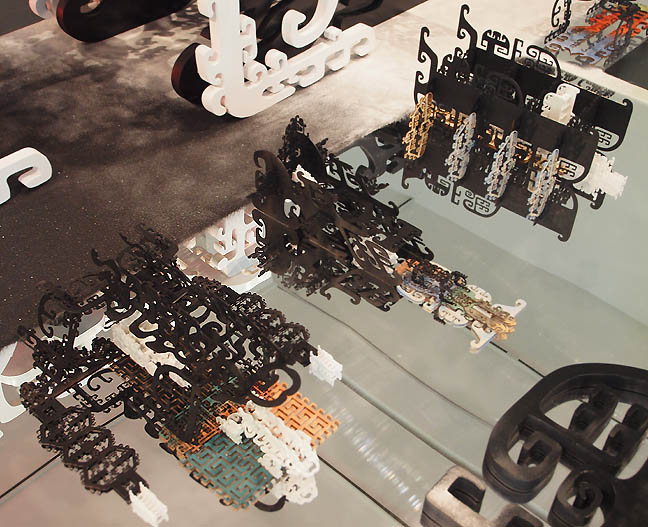
This distinct hierarchy of scale, like a medieval court painting where the King is largest might indicate that the Insect and Vehicle are the leaders and the rest are some sort of sci-fi computer hive vassals? Regardless, it feels ritualistic but being contemporary art but the only rite at work here is one of viewer's curiosity and close proximity discoveries. Perhaps that is one of Art's greatest the lessons... the way it ritualizes curiosity in the face of enigma? One could also think of the exhibition as a court or stage as Murphy will preform with her performance duo MSHR next month? Still, I prefer this unpopulated version since not knowing what kind of creatures populate and use this city it is half its charm. This ritualization of space is the cult of Brenna Murphy's work and its rampantly repeated design quotient is perhaps the chant it intones within the gallery. The fact that it is very well made with the help of computers certainly explodes the hand made "crafty" fetishes that have been oversimplifying the Portland art scene as of late. Craft doesn't require the hand, in fact it can overshadow meaning in vain self congratulatory way. 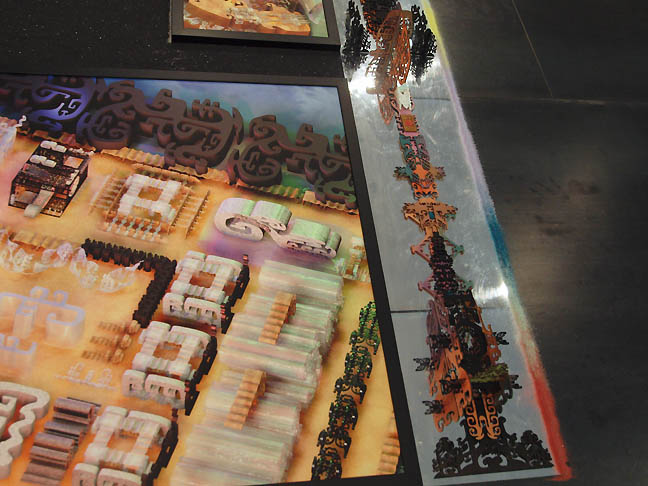
What's more there is symmetry between Murphy's enigmatic macro-anachro-circuitry structures and these head scratching times where our increasingly interconnected and powerful information systems keep us painfully aware of what is going on in the world as well as real time updates on the limited resources available to fix it. In short, rather than entering an age of digital omniscience, this technological integration has only made us more aware of what we don't know and can't address. This leads to a kind of digital powerlessness and the labyrinth of occult structures that Murphy has built are a kind of balm against it... creating a parallel world with cryptically computer designed yet sculptural structures rather than just a screen rendering. It's this tangible sense of enigma pervasive in Murphy's work that has force and by giving it physical form it changes the end user or viewer's experience. What's more, this is perhaps the first time any installation artist has made good use of the very cool metal floors in this particular gallery space. Murphy's work does have precedent. Other artists have addressed this Mandelbrotian vastness of anxiety and discovery in the past. Jackson Pollock dripped paint, Jay Defeo obsessed over the radial symmetry of just one work The Rose and Stanley Landsman created the Infinity Chamber. That said none have the tangibility and tiny etched map making of the ubiquitous microprocessor that Murphy has intoned. Besides Pollock and Landsman were also Cold War era artists. Later artists like Philip Taaffe and Judy Pfaff also took to using and overlaying patterns but neither was trying to use computers to carve out a new type of tribal iconography like Murphy has, they were postmodernists seeking to use symbols without referent. In the early aughts the Forcefield collective created a similar tribal world but focused more on knitted suits where Murphy has focused more on creating set pieces and temple like structures. Overall, Murphy presents a dada-esque digital totemicism, she isn't using signs... she is obfuscating or encrypting them to carve out aesthetic space. Though people are talking about the show, many have a tough time finding terms to discuss it at length. First let's just look at the title, Lattice~Face Parameter Chant. "Lattice" is a structural strategy, giving the exhibition (which does have tons of lattice) a generative sense of becoming and expansion. As social creatures, humans are very keyed into the face but in this show the faces are only Rorschach suggestive. But but being imbedded in a lattice matrix there is a sense of face as a kind of structural code... not unlike Facebook and the NSA's facial recognition techniques. Which leads us to the parameter chant. The chanted parameters are both the repeating lattice of Murphy's work and the viewer's attention. It's almost like one of old pulp fiction stories where an explorer crashes and is nursed back to health by a lost civilization, which then translates the advanced technology of a radio or airplane into their own cosmology. 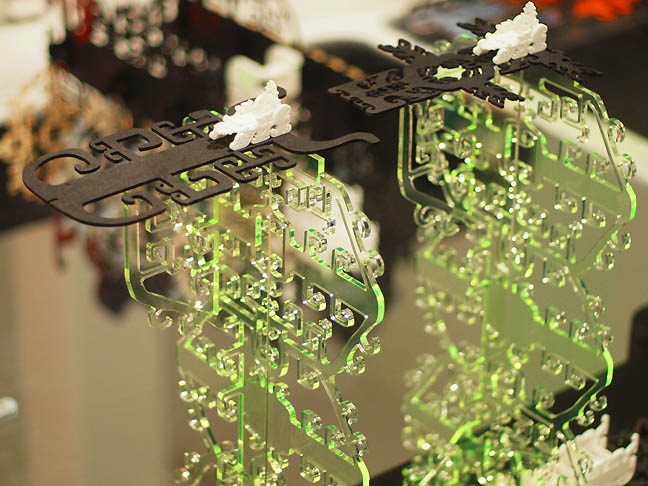
Like a computer circuit Murphy's installation is a maze... but the only minotaur here is the viewers own curiosity and doubt. There are towers made of jade green Plexiglas the resemble some kind of Chinese lattice gate or perhaps a transformer on a circuit board or even a table at some futuristic Asian-ish casino. The only thing I know for certain about this work is that everything in it looks exotic. I've followed Murphy's work for years, first through the Oregon Painting Society collective then her MSHR duo but this work (which has been exhibited in Germany and San Francisco's Yerba Buena center already) is some of her very best work born out of the true energy and excitement of the dynamic and more than a little tribal Portland art scene . It has Promethean fire perfectly tuned to our age. In short, this is a rare moment when a Pearl District gallery seems, "with it." Right now a whole slew of Portland artists are utilizing design as a tribal signifier and mandala for embracing the existential and technological unknown. The group of perhaps 30+ notable practitioners (Paula Rebsom, Jordan Tull, Damien Gilley, Zachary Davis, Alex Mackin Dolan, Laura Fritz, Nathaniel Thayer Moss, Laura Hughes, Avantika Bawa, Philip Iosca, Arcy Douglass, Jesse Hayward, David Corbett, Midori Hirose, Oregon Painting Society, Benjamin Buswell and Kyle Thompson etc. to name just a few) all compare notes in a loose to tight knit community of peers finding very different solutions to very similar questions. Many are quite active outside Portland... see the pattern? I am so glad Upfor has taken on the task of presenting Brenna Murphy's work, someone has to champion this sort of relevant work. Portland may be the hottest and most unpredictable city in the country, which makes many... including myself and curators traveling through town wonder why its most official galleries and museums are so on the sidelines of that energy? This show marks an interesting moment when Portland rediscovers itself after other particularly attuned parts of planet (including Portland's alternative scene) have already gone gaga over it. Posted by Jeff Jahn on October 16, 2013 at 4:51 | Comments (0) Comments Post a comment Thanks for signing in, . Now you can comment. (sign out)
(If you haven't left a comment here before, you may need to be approved by
the site owner before your comment will appear. Until then, it won't appear
on the entry. Thanks for waiting.)
|
| s p o n s o r s |
 |
 |
 |
 |
 |
 |
 |
 |
 |
 |
 |
 |
 |
 |

|
Site Design: Jennifer Armbrust | • | Site Development: Philippe Blanc & Katherine Bovee | |

